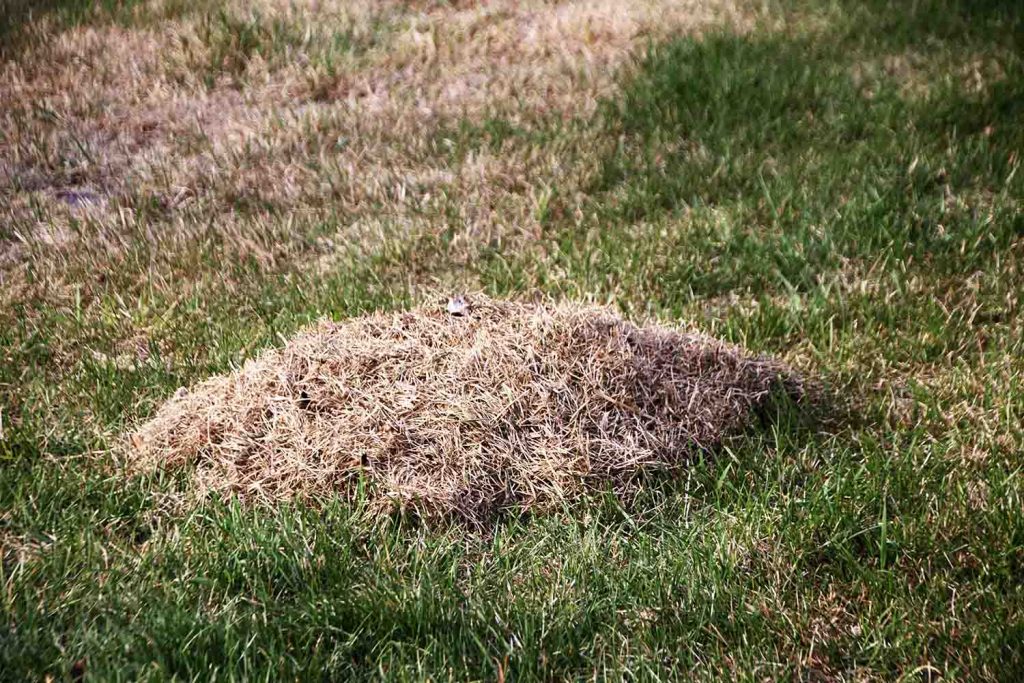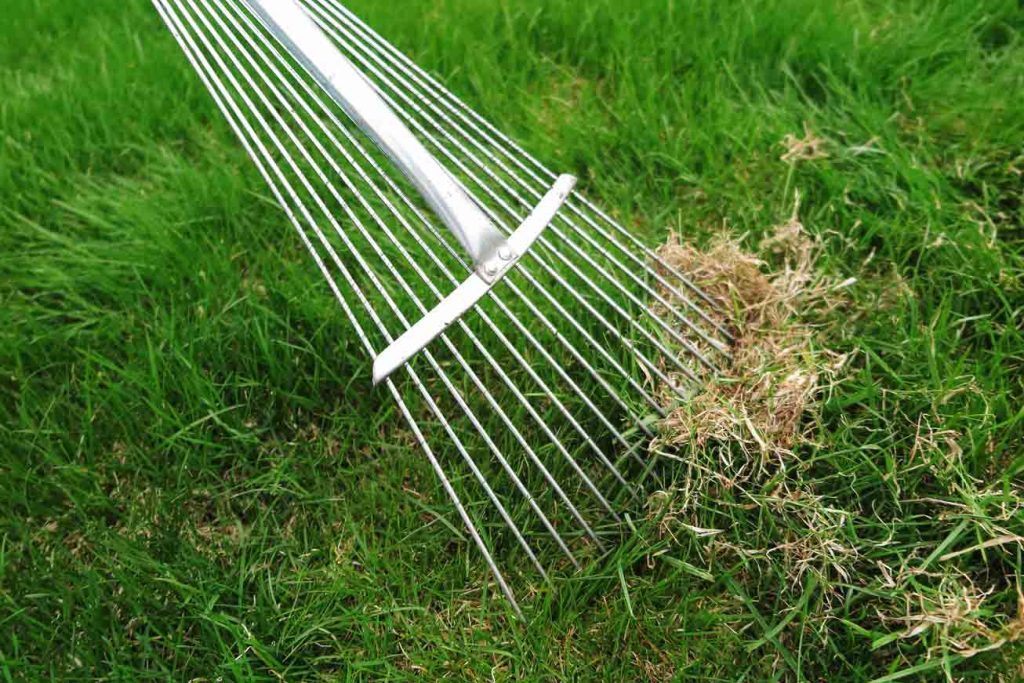Keeping your grass green and strong is not always as easy as it sounds. There are many issues that can befall a lawn, and some are not even noticeable to the untrained eye. One such issue is thatch buildup that slowly hinders proper growth and development of healthy grass blades.
Unfortunately, if you have never heard of thatch and don’t know how to identify it, your lawn is at risk for a number of additional issues… but don’t worry! Summit Lawns is here to explain what thatch is, where it comes from, and how you can prevent it from damaging your beautiful landscapes.
Defining Thatch

Lawn thatch is a natural layer of organic material that accumulates between the soil surface and the living grass blades in a lawn. It primarily consists of dead grass and other decaying organic debris that gradually builds up over time. Thatch is inevitable in a lawn and acts as a protective barrier for the soil. It is a byproduct of the continuous growth and decomposition of grass and other vegetation in your lawn.
Though dead grass blades are usually what first comes to mind when we think of thatch, it is often composed of organic matter like roots, fallen leaves, stems and flowers of weeds, and anything else that decomposes on top of a lawn. A thin layer of thatch may not even be visible unless you are diligently searching for it, but it is important to keep a watchful eye on how much thatch accumulates in your lawn.
Identifying Thatch

Identifying thatch in a lawn is relatively straightforward and can be done through visual inspection and physical examination. You may have never noticed thatch in your lawn if you weren’t looking for it, as it is a naturally occurring part of all lawns, but it is something you can identify and monitor. Thatch typically appears as a brown or yellowish-brown layer of what appears to be dead grass clippings or very fine straw. It may resemble a dense and spongy mat, and, in severe cases, it can be several inches thick. One of the simplest methods is to part the grass with your hand or a gardening tool and closely examine the area near the soil surface. Keep the below information in mind when trying to determine how much thatch is in your lawn:
- A reliable indicator of thatch is when your lawn feels excessively soft and springy underfoot, rather than firm and slightly compact.
- If water puddles on your lawn instead of being absorbed, or if you notice poor grass growth despite adequate care, these could also be signs of excessive thatch.
- Thatch that has accumulated to unhealthy levels will pile up on top of your healthy grass when you rake your lawn or perform other lawn care tasks.
- Take a 2-inch-deep sample of soil out of your lawn. If more than half of the sample is dead grass and light-colored organic matter rather than darker, normal soil, your lawn has too much thatch.
Pros & Cons Of Thatch

While a certain amount of thatch is beneficial, excessive thatch buildup can impede the health of your lawn by obstructing water, air, and nutrient penetration into the soil and promoting conditions conducive to pests and diseases. Whether thatch is good or bad in a lawn depends on its quantity and the balance achieved. In moderation, thatch can offer certain benefits to your lawn. It acts as a natural insulator, protecting the soil and grass roots from temperature extremes. It can also help in retaining moisture, preventing soil erosion, and offering some resilience against foot traffic. However, when thatch accumulates excessively, it becomes detrimental to the health of your lawn. Here's a pros and cons list to illustrate the balance:
Pros Of Healthy Thatch (½ an inch or less):
- Insulation: Thatch provides insulation, protecting grass roots from temperature fluctuations.
- Moisture Retention: It helps retain moisture, reducing the risk of drought stress.
- Soil Erosion Prevention: Thatch acts as a natural barrier against soil erosion.
- Resilience: A thin layer of thatch can offer some resilience against foot traffic and play.
Cons Of Excessive Thatch (more than ½ an inch):
- Nutrient Blockage: Thick thatch hinders the penetration of essential nutrients, water, and air to the roots.
- Pest & Disease Habitat: Excessive thatch can create an ideal environment for pests and diseases.
- Drought Susceptibility: Lawns with excessive thatch are more susceptible to drought stress.
- Poor Aeration: It inhibits soil aeration, leading to compacted soil and reduced root growth.
Thatch Buildup & Grass Types
Certain types of lawns are more prone to excessive thatch buildup than others. Cool-season grasses such as Kentucky bluegrass, fine fescue, and perennial ryegrass are often more susceptible to thatch accumulation. These grass varieties tend to produce a greater volume of organic material, especially if they are heavily fertilized and mowed too frequently or too short. Lawns in regions with a temperate climate, where cool-season grasses are prevalent (like here in Nebraska), are more likely to experience thatch problems due to the favorable conditions for rapid grass growth and decomposition of organic matter.
While warm-season grasses like Bermudagrass or Zoysiagrass are generally less prone to thatch buildup, they too can develop thatch if subjected to unfavorable maintenance practices, such as excessive fertilization and infrequent aeration. Understanding the grass type in your lawn and adopting appropriate lawn care practices is essential to manage thatch effectively.
How To Prevent Excessive Thatch

Preventing thatch is crucial for maintaining a healthy lawn, and there are some basic practices that can help keep that at a normal level. Consider utilizing the services of a professional lawn care company, like Summit Lawns, in order to keep your lawn healthy and avoid excess thatch. If you want to prevent thatch on your own, remember the following lawn care tips:
- Deep lawn watering sessions should be prioritized over frequent shallow watering. Infrequent, deep watering encourages roots to grow deeper, reducing the accumulation of thatch near the surface.
- Regular mowing at an appropriate height (the top ⅓ of the lawn) is also important, as cutting too short can stress the grass and lead to increased thatch production.
- Fertilize properly to avoid excessive nitrogen, which encourages rapid grass growth and contributes to thatch accumulation.
- Rake leaves and debris as soon as they fall onto your lawn. The more debris that is allowed to decompose on top of your soil, the more thatch buildup you will have in your lawn!
